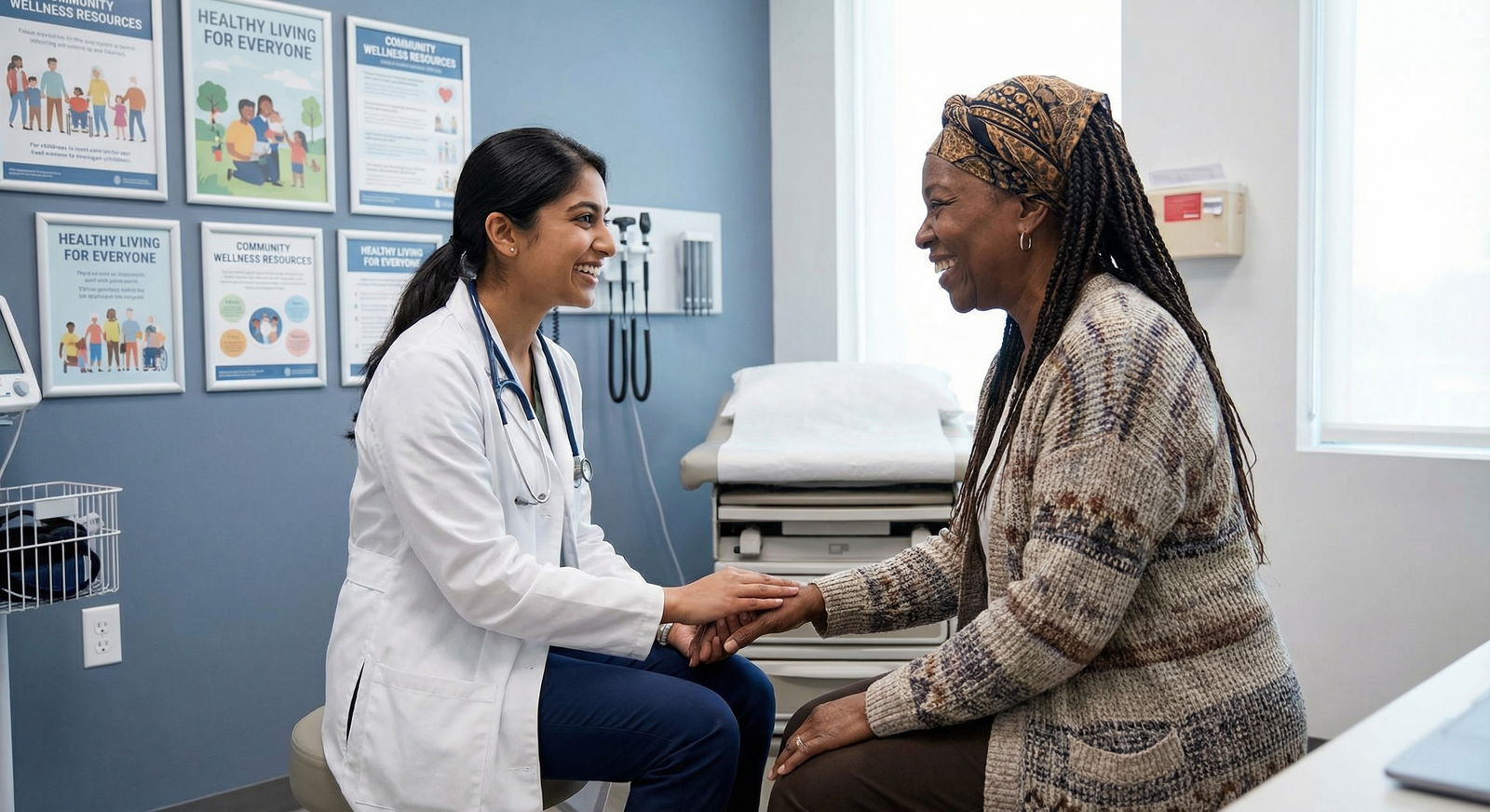Why Diversity in Residency Training is Vital for Future Physicians

Diversity in Training: Why It Matters in Your Residency Choice
Residency training is where you evolve from a medical student into an independent physician. The colleagues you learn from, the patients you treat, and the environment in which you train will shape not only your career path, but also the way you care for people for decades to come. One factor that increasingly defines high-quality training—and that should strongly influence your residency choice—is diversity.
Diversity in residency training is not a checkbox or a PR slogan. It is directly tied to Cultural Competence, Health Equity, and the quality and safety of Patient Care. Choosing a residency program that values and lives Healthcare Diversity will better prepare you to practice in a rapidly changing, multicultural healthcare system.
This guide explains why diversity matters in Residency Training, how it affects your day-to-day learning and future practice, and concrete strategies to evaluate a program’s true commitment to diversity when you’re making your rank list.
Understanding Diversity in Residency Training
What “Diversity” Really Means in Medical Education
In residency, diversity encompasses much more than race or ethnicity. It includes:
- Race and ethnicity
- Gender identity and expression
- Sexual orientation
- Socioeconomic background and educational pathway
- Disability status (visible and invisible)
- Religion and spiritual beliefs
- Immigration status and language
- Geographic origin (rural vs. urban, international vs. U.S. trained)
- Diversity of thought, lived experience, and career goals
A residency program that truly values diversity:
- Recruits and retains residents and faculty from varied backgrounds
- Integrates diverse perspectives into teaching, evaluation, and leadership
- Creates an environment where different experiences are welcomed and leveraged—not simply “tolerated”
In this context, diversity is inseparable from inclusion (everyone can participate fully) and equity (everyone has what they need to succeed, which may not be the same resources for every person).
Why Diversity Is Foundational to Modern Medicine
As patient populations become more heterogeneous and health systems more complex, medicine demands physicians who can:
- Navigate language barriers
- Understand cultural health beliefs and practices
- Recognize and address structural and social determinants of health
- Identify and mitigate inequities in diagnosis, treatment, and outcomes
These are not “soft skills”—they are core competencies that influence mortality, morbidity, and patient trust. A diverse residency environment is one of the most powerful ways to build them.
How Diversity in Training Improves Patient Care and Physician Development
1. Training That Reflects the Communities You Will Serve
The U.S. population is increasingly diverse across almost every demographic dimension. Residency programs that prioritize Healthcare Diversity prepare you to:
- Treat patients whose primary language is not English
- Understand disease prevalence and presentation across different racial and ethnic groups
- Navigate cultural attitudes toward mental health, chronic disease, end-of-life care, and preventive medicine
- Recognize how socioeconomic status, housing, employment, and immigration status shape health
Patients report better satisfaction, communication, and trust when they perceive that their clinician understands their background and values. This doesn’t require a perfect demographic “match” between doctor and patient; it requires cultural competence supported by training in diverse environments.
Example:
A resident trained in a program with a large immigrant population may gain experience:
- Using professional interpreters effectively
- Addressing vaccine hesitancy grounded in prior experiences with healthcare systems abroad
- Navigating complex insurance and documentation barriers
Those skills translate directly to improved Patient Care in almost any future practice setting.
2. Building Cultural Competence and Empathy
Cultural Competence is not a checklist of facts about different groups—it is an ongoing skill set that includes:
- Self-awareness of your own biases and assumptions
- Curiosity about patients’ beliefs and values
- Ability to adapt communication and care plans to the patient’s context
- Willingness to recognize when you don’t know something and ask respectfully
Training alongside residents and faculty from diverse backgrounds accelerates your growth in these areas. You are challenged to:
- Hear perspectives very different from your own
- Re-examine how you interpret patient behavior
- Reflect on how your own identity and experiences influence clinical decisions
Over time, this leads to:
- More nuanced history-taking
- Better shared decision-making
- More individualized care plans
And ultimately, better outcomes—especially for patients historically marginalized in the healthcare system.
3. Enhancing Critical Thinking and Clinical Problem-Solving
Diverse teams consistently outperform homogenous teams on tasks that require creativity and complex problem-solving. Residency is full of such tasks—from diagnostic puzzles to system-level quality improvement.
In a diverse program, you are more likely to:
- Hear alternative explanations for diagnostic dilemmas
- See different approaches to complex communication (e.g., breaking bad news in different cultural contexts)
- Learn varied practice styles, enabling you to build a more flexible and adaptable approach
Diversity in training encourages:
- Questioning assumptions instead of defaulting to “how it’s always done”
- Spotting blind spots, especially in care of marginalized groups
- Collaborating across different disciplines and backgrounds to design better care pathways
For example, an interdisciplinary team including a resident from a rural background, a social worker familiar with housing insecurity, and a faculty member with expertise in LGBTQ+ health will likely design a more comprehensive discharge plan for a complex patient than a more homogenous group.
4. Addressing Health Disparities and Advancing Health Equity
Health disparities—differences in health status or outcomes between groups—are often driven by systemic inequities and social determinants of health. Residency programs that immerse trainees in diverse patient populations, particularly underserved communities, are uniquely positioned to:
- Expose residents to the realities of structural racism, economic inequality, and discrimination
- Teach practical skills for addressing barriers (transportation, insurance, food insecurity, literacy)
- Encourage advocacy at multiple levels (clinic, hospital, community, policy)
When you train in such settings, you are better prepared to:
- Identify disparities in your own practice
- Use data to track and address inequities
- Participate in quality improvement initiatives that promote Health Equity
- Advocate for patients and communities beyond the walls of the hospital
This is increasingly recognized by accreditation bodies and hiring institutions as a core element of high-quality medical education.

What to Look for in a Diverse Residency Program
When choosing among residency programs, you are not just choosing a location or prestige level—you are choosing the environment that will shape your values, skills, and identity as a physician. Assessing a program’s commitment to Healthcare Diversity requires looking beyond a single slide in a recruitment presentation.
1. Program Demographics and Representation
Start by examining who actually trains and teaches there.
Questions to explore:
- What is the demographic makeup of current residents and recent graduates?
- Is there diversity among program leadership, chief residents, and faculty?
- Are underrepresented groups present only at junior levels, or also in decision-making roles?
- Do visiting student programs and funded away rotations target students from underrepresented backgrounds?
Actionable steps:
- Review the residency website and social media; look for multiple years of class photos and resident spotlights.
- Ask during interviews:
- “How has resident and faculty diversity changed over the past 5–10 years?”
- “What strategies does your program use to recruit and retain residents from underrepresented groups?”
- Talk to current residents—especially those whose identities or interests align with yours—about their experiences.
Representation alone is not enough, but it is a visible starting point. A program that consistently recruits and promotes diverse residents and faculty is more likely to have structures that genuinely support them.
2. Curriculum: How Is Diversity Built into Your Training?
A truly inclusive program integrates diversity into the core curriculum, not just as a one-time lecture.
Look for:
- Longitudinal training in:
- Cultural Competence and communication
- Social determinants of health and structural competency
- Implicit bias and microaggressions
- Trauma-informed care
- LGBTQ+ health, reproductive health equity, and disability-inclusive care
- Case conferences and M&M (morbidity and mortality) discussions that explicitly address equity and bias
- Opportunities to participate in:
- Community health rotations
- Global health experiences (with ethical, sustainable partnerships)
- Research or QI projects focused on disparities or Health Equity
Questions to ask:
- “How are health disparities and social determinants of health incorporated into your didactics and clinical teaching?”
- “Can you share examples of QI or research projects residents have done related to Health Equity or vulnerable populations?”
- “Are there required rotations in community health centers, public hospitals, or rural clinics?”
A program that can provide specific examples—rather than vague statements—likely has more robust structures in place.
3. Community Engagement and Patient Population
The clinical environment is where you internalize habits of Patient Care. Consider:
- Who are the primary patients served by the program?
- Urban safety-net population?
- Rural and frontier communities?
- Large immigrant or refugee population?
- Correctional health, addiction treatment, or behavioral health focus?
- Are there structured opportunities for:
- Mobile clinics, school-based clinics, or shelter-based care?
- Collaboration with local public health departments or community organizations?
- Outreach events (health fairs, screenings, vaccine drives)?
Actionable steps:
- Ask residents about:
- Their most meaningful patient interactions
- How often they use interpreters
- How often they see patients from marginalized or underserved groups
- Review hospital or clinic community benefit reports if available
Programs deeply engaged with their communities tend to produce residents who are more attuned to Health Equity and better equipped for real-world practice.
4. Support Systems and Inclusive Environment
Diversity without support can be harmful. You need an environment where you—and your colleagues—can thrive.
Look for:
- Formal mentorship programs, including mentors from similar backgrounds or with shared interests (e.g., first-generation college/medical students, LGBTQ+ physicians, women in leadership, physician-parents).
- Affinity and resource groups (e.g., SNMA/LMSA alumni networks, LGBTQ+ groups, women in medicine groups).
- Wellness and mental health resources that acknowledge and address unique stressors for underrepresented residents.
- Transparent policies on:
- Discrimination and harassment
- Reporting mechanisms and protection from retaliation
- Parental leave and caregiver support
- Reasonable accommodations for disability
Questions to ask:
- “What affinity groups or identity-based support structures exist for residents?”
- “Can you describe a situation where a resident raised a concern about bias or discrimination and how the program responded?”
- “How are residents involved in diversity, equity, and inclusion (DEI) initiatives and decision-making?”
You are looking for evidence that the program not only recruits diverse residents, but also retains and supports them through graduation and beyond.
5. Institutional Commitment and Accountability
Finally, consider the broader institution:
- Does the department or hospital have:
- A formal DEI office or leadership role with real authority?
- Publicly stated goals related to Healthcare Diversity and Health Equity?
- Data on recruitment, retention, and promotion by demographic group?
- Are residents meaningfully involved in:
- Program evaluation and curriculum development
- Diversity or equity task forces
- Strategic planning around community engagement?
Programs that measure progress and share data transparently are more likely to be accountable and committed to continuous improvement.
Long-Term Impact: How Diverse Training Shapes Your Career
Better Patient Outcomes and Safer Care
Residency training that emphasizes diversity and Cultural Competence can lead to:
- Improved adherence to treatment plans through better communication
- More accurate diagnosis through awareness of varying disease prevalence and presentations
- Safer prescribing practices that consider cultural beliefs, literacy, and access
- Reduced miscommunication and errors in cross-cultural contexts
These competencies are increasingly recognized by employers, professional boards, and patients as essential components of quality care.
Enhanced Career Opportunities and Leadership Potential
Physicians trained in diverse environments often:
- Feel more comfortable practicing in a wide range of settings (urban, rural, community, academic, global)
- Are more competitive for roles in:
- Academic medicine and medical education
- Hospital and health system leadership
- Public health and policy
- Nonprofit and community-based organizations
- Are sought after for committees and initiatives focused on Health Equity, quality improvement, and community partnerships
As health systems and accrediting bodies intensify their focus on equity and inclusion, your ability to demonstrate concrete experience in these areas will be a career asset.
Personal Growth and Professional Identity Formation
Beyond CV lines, diverse Residency Training shapes:
- How you see your role as a physician in society
- How you understand and relate to patients, colleagues, and communities
- The kinds of problems you feel called to work on throughout your career
Many residents trained in diverse settings describe a stronger sense of purpose, a deeper understanding of justice in healthcare, and a sustained commitment to underserved populations—even if they later practice in more resourced environments.
Real-World Examples: Diversity in Action
Chicago’s Inner-City Health Program
In a residency track based in Chicago’s inner-city safety-net clinics, interns and residents:
- Manage high volumes of chronic diseases like diabetes and hypertension in resource-limited settings
- Work closely with community health workers to address housing instability, food insecurity, and transportation barriers
- Learn to coordinate with social services, legal aid, and community organizations
Graduates of this type of program often report:
- Greater confidence managing complex social situations
- More sophisticated approaches to medication affordability and adherence
- Lifelong engagement in advocacy and community-partnered care
ACGME Insights on Diversity and Competence
The Accreditation Council for Graduate Medical Education (ACGME) has highlighted that residents who train in diverse environments demonstrate:
- Increased confidence in caring for patients from backgrounds different from their own
- Improved communication skills in cross-cultural encounters
- Greater awareness of health disparities and motivation to address them
These findings reinforce that diversity in training is not an “extra”—it is integral to high-quality Residency Training that prepares you for modern practice.

FAQs: Choosing a Residency Program with Strong Diversity and Equity
1. Why is diversity in residency training so important for my future career?
Diversity in Residency Training directly shapes your ability to deliver high-quality, equitable Patient Care. It builds Cultural Competence, hones your communication skills, and exposes you to the realities of Health Equity and health disparities. These experiences:
- Make you a more adaptable and effective clinician across settings
- Enhance your competitiveness for leadership, academic, and advocacy roles
- Align your training with the expectations of modern healthcare systems, accrediting bodies, and patients
In short, diverse training environments help you become not just a competent physician, but a physician prepared for the real world.
2. How can I realistically assess a program’s commitment to diversity during interview season?
Beyond brochures and websites, you can:
- Talk directly with residents, including those from underrepresented backgrounds, and ask:
- “Do you feel supported here?”
- “Have you seen the program respond constructively to concerns about bias or discrimination?”
- Ask faculty and PDs for specifics:
- Examples of curriculum content on health disparities and social determinants
- Data on recruitment and retention of underrepresented residents and faculty
- Concrete DEI initiatives and outcomes over the last 3–5 years
- Observe the environment during interviews:
- Who is present and speaking (residents, faculty, leadership)?
- Are diverse residents showcased only on “diversity slides” or genuinely integrated across the program?
- Follow up after interviews:
- Email residents with targeted questions
- Attend virtual Q&A sessions or second-look events focused on diversity and wellness
Patterns across these conversations will tell you more than any single statement.
3. I’m not from an underrepresented group. Why should diversity matter in my residency choice?
Diversity in training benefits every resident, regardless of background. In a diverse and inclusive program, you gain:
- Richer clinical exposure to varied patient populations
- Enhanced critical thinking through diverse team perspectives
- Better preparation for credentialing, practice, and leadership in modern healthcare
- Opportunities to develop advocacy and system-improvement skills that are increasingly valued across specialties
Moreover, all physicians share responsibility for advancing Health Equity. Training in an environment that models and teaches this work is part of your professional development, not just a matter for certain identity groups.
4. What if a program has limited visible diversity but strong community exposure or curriculum—should I still consider it?
Yes, but evaluate carefully and in context:
- Some programs (e.g., in rural areas) may serve highly diverse or underserved communities even if their resident cohort appears more homogenous.
- Ask how the program is actively working to increase diversity and inclusion among residents and faculty.
- Explore whether the curriculum genuinely addresses:
- Social determinants of health
- Care for marginalized groups
- Structural competency and Health Equity
- Assess whether you feel the environment is inclusive and supportive, even if numerical diversity is not yet where you might hope.
If the program demonstrates clear commitment, transparency, and progress, it may still offer strong training with substantial diversity of patient experience.
5. How can I contribute to diversity and equity efforts as a resident?
Regardless of your identity or background, you can:
- Participate in or help organize DEI or Health Equity committees and projects
- Engage in quality improvement focused on disparities (e.g., closing gaps in screening rates across demographic groups)
- Mentor or support medical students and premeds from underrepresented backgrounds
- Learn from community organizations and partners rather than “parachuting in” with short-term projects
- Reflect on and address your own biases through ongoing learning, feedback, and self-assessment
When you evaluate programs, ask how residents are supported and recognized for this work—through protected time, mentorship, academic credit, or leadership opportunities.
Choosing a residency program is ultimately about aligning your training environment with the kind of physician you want to become. Prioritizing diversity, inclusion, and Health Equity in your Residency Training is not just the “right thing” to do; it is a strategic decision that will make you a stronger, more effective, and more fulfilled physician throughout your career.

SmartPick - Residency Selection Made Smarter
Take the guesswork out of residency applications with data-driven precision.
Finding the right residency programs is challenging, but SmartPick makes it effortless. Our AI-driven algorithm analyzes your profile, scores, and preferences to curate the best programs for you. No more wasted applications—get a personalized, optimized list that maximizes your chances of matching. Make every choice count with SmartPick!
* 100% free to try. No credit card or account creation required.



















